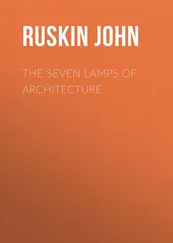John Ruskin - The Poetry of Architecture
Здесь есть возможность читать онлайн «John Ruskin - The Poetry of Architecture» — ознакомительный отрывок электронной книги совершенно бесплатно, а после прочтения отрывка купить полную версию. В некоторых случаях можно слушать аудио, скачать через торрент в формате fb2 и присутствует краткое содержание. Жанр: foreign_antique, foreign_home, literature_19, visual_arts, на английском языке. Описание произведения, (предисловие) а так же отзывы посетителей доступны на портале библиотеки ЛибКат.
- Название:The Poetry of Architecture
- Автор:
- Жанр:
- Год:неизвестен
- ISBN:нет данных
- Рейтинг книги:5 / 5. Голосов: 1
-
Избранное:Добавить в избранное
- Отзывы:
-
Ваша оценка:
- 100
- 1
- 2
- 3
- 4
- 5
The Poetry of Architecture: краткое содержание, описание и аннотация
Предлагаем к чтению аннотацию, описание, краткое содержание или предисловие (зависит от того, что написал сам автор книги «The Poetry of Architecture»). Если вы не нашли необходимую информацию о книге — напишите в комментариях, мы постараемся отыскать её.
The Poetry of Architecture — читать онлайн ознакомительный отрывок
Ниже представлен текст книги, разбитый по страницам. Система сохранения места последней прочитанной страницы, позволяет с удобством читать онлайн бесплатно книгу «The Poetry of Architecture», без необходимости каждый раз заново искать на чём Вы остановились. Поставьте закладку, и сможете в любой момент перейти на страницу, на которой закончили чтение.
Интервал:
Закладка:
58. I have always rejoiced in the thought, that our native highland scenery, though, perhaps, wanting in sublimity, is distinguished by a delicate finish in its details, and by a unanimity and propriety of feeling in the works of its inhabitants, which are elsewhere looked for in vain; and the reason of this is evident. The mind of the inhabitant of the continent, in general, is capable of deeper and finer sensations than that of the islander. It is higher in its aspirations, purer in its passions, wilder in its dreams, and fiercer in its anger; but it is wanting in gentleness, and in its simplicity; naturally desirous of excitement, and incapable of experiencing, in equal degree, the calmer flow of human felicity, the stillness of domestic peace, and the pleasures of the humble hearth, consisting in everyday duties performed, and everyday mercies received; consequently, in the higher walks of architecture, where the mind is to be impressed or elevated, we never have equaled, and we never shall equal, them. It will be seen hereafter, when we leave the lowly valley for the torn ravine, and the grassy knoll for the ribbed precipice, that, if the continental architects cannot adorn the pasture with the humble roof, they can crest the crag with eternal battlements; 11if they cannot minister to a landscape's peace, they can add to its terror; and it has been already seen, that, in the lowland cottages of France and Italy, where high and refined feelings were to be induced, where melancholy was to be excited, or majesty bestowed, the architect was successful, and his labor was perfect: but, now, nothing is required but humility and gentleness; and this, which he does not feel, he cannot give: it is contrary to the whole force of his character, nay, even to the spirit of his religion. It is unfelt even at the time when the soul is most chastened and subdued; for the epitaph on the grave is affected in its sentiment, and the tombstone gaudily gilded, or wreathed with vain flowers.

Fig. 6. The Highest House in England.
59. We cannot, then, be surprised at the effort at ornament and other fancied architectural beauties, which injure the effect of the more peaceful mountain scenery abroad; but still less should we be surprised at the perfect propriety which prevails in the same kind of scenery at home; for the error which is there induced by one mental deficiency, is here prevented by another. The uncultivated mountaineer of Cumberland has no taste, and no idea of what architecture means; he never thinks of what is right, or what is beautiful, but he builds what is most adapted to his purposes, and most easily erected: by suiting the building to the uses of his own life, he gives it humility; and, by raising it with the nearest material, adapts it to its situation. This is all that is required, and he has no credit in fulfilling the requirement, since the moment he begins to think of effect, he commits a barbarism by whitewashing the whole. The cottages of Cumberland would suffer much by this piece of improvement, were it not for the salutary operation of mountain rains and mountain winds.
60. So much for the hill dwellings of our own country. I think the examination of the five examples of the cottage which I have given have furnished all the general principles which are important or worthy of consideration; and I shall therefore devote no more time to the contemplation of individual buildings. But, before I leave the cottage altogether, it will be necessary to notice a part of the building which I have in the separate instances purposely avoided mentioning, that I might have the advantage of immediate comparison; a part exceedingly important, and which seems to have been essential to the palace as well as to the cottage, ever since the time when Perdiccas received his significant gift of the sun from his Macedonian master, περιγραψας τον ἡλιον, ὁς ην κατα την καπνοδοκην ες τον οικον εσεχων. 12And then I shall conclude the subject by a few general remarks on modern ornamental cottages, illustrative of the principle so admirably developed in the beauty of the Westmoreland building; to which, it must be remembered, the palm was assigned, in preference to the Switzer's; not because it was more labored, but because it was more natural.
Oxford, Jan., 1838.
V.
A CHAPTER ON CHIMNEYS
61. It appears from the passage in Herodotus, which we alluded to in the last paper, that there has been a time, even in the most civilized countries, when the king's palace was entirely unfurnished with anything having the slightest pretension to the dignity of chimney tops; and the savory vapors which were wont to rise from the hospitable hearth, at which the queen or princess prepared the feast with the whitest of hands, escaped with indecorous facility through a simple hole in the flat roof. The dignity of smoke, however, is now better understood, and it is dismissed through Gothic pinnacles, and (as at Burleigh House) through Tuscan columns, with a most praiseworthy regard to its comfort and convenience. Let us consider if it is worth the trouble.
62. We advanced a position in the last paper, that silence is never perfect without motion. That is, unless something which might possibly produce sound is evident to the eye, the absence of sound is not surprising to the ear, and, therefore, not impressive. Let it be observed, for instance, how much the stillness of a summer's evening is enhanced by the perception of the gliding and majestic motion of some calm river, strong but still; or of the high and purple clouds; or of the voiceless leaves, among the opening branches. To produce this impression, however, the motion must be uniform, though not necessarily slow. One of the chief peculiarities of the ocean thoroughfares of Venice, is the remarkable silence which rests upon them, enhanced as it is by the swift, but beautifully uniform motion of the gondola. Now, there is no motion more uniform, silent or beautiful than that of smoke; and, therefore, when we wish the peace or stillness of a scene to be impressive, it is highly useful to draw the attention to it.
Конец ознакомительного фрагмента.
Текст предоставлен ООО «ЛитРес».
Прочитайте эту книгу целиком, купив полную легальную версию на ЛитРес.
Безопасно оплатить книгу можно банковской картой Visa, MasterCard, Maestro, со счета мобильного телефона, с платежного терминала, в салоне МТС или Связной, через PayPal, WebMoney, Яндекс.Деньги, QIWI Кошелек, бонусными картами или другим удобным Вам способом.
1
Compare Lectures on Architecture and Painting , I. § 16.
2
Compare with this chapter, Modern Painters , vol. iv. chap. 1.
3
The annexed illustration will, perhaps, make the remarks advanced more intelligible. The building, which is close to the city of Aosta, unites in itself all the peculiarities for which the Italian cottage is remarkable: the dark arcade, the sculptured capital, the vine-covered gallery, the flat and confused roof; and clearly exhibits the points to which we wish particularly to direct attention; namely, brightness of effect, simplicity of form, and elevation of character. Let it not be supposed, however, that such a combination of attributes is rare; on the contrary, it is common to the greater part of the cottages of Italy. This building has not been selected as a rare example, but it is given as a good one. [These remarks refer to a cut in the magazine text, represented in the illustrated edition by a photogravure from the original sketch.]
Читать дальшеИнтервал:
Закладка:
Похожие книги на «The Poetry of Architecture»
Представляем Вашему вниманию похожие книги на «The Poetry of Architecture» списком для выбора. Мы отобрали схожую по названию и смыслу литературу в надежде предоставить читателям больше вариантов отыскать новые, интересные, ещё непрочитанные произведения.
Обсуждение, отзывы о книге «The Poetry of Architecture» и просто собственные мнения читателей. Оставьте ваши комментарии, напишите, что Вы думаете о произведении, его смысле или главных героях. Укажите что конкретно понравилось, а что нет, и почему Вы так считаете.












